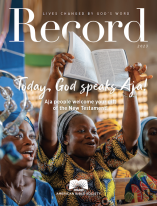Celebrating Passover as both a Christian and a Jew
How my Jewish roots bring me closer to Jesus
The people are to take some of the blood and put it on the doorposts and above the doors of the houses in which the animals are to be eaten…. The blood on the doorposts will be a sign to mark the houses in which you live. When I see the blood, I will pass over you and will not harm you when I punish the Egyptians. 14You must celebrate this day as a religious festival to remind you of what I, the Lord, have done. Celebrate it for all time to come.”
—Exodus 12:7, 13, 14
Although I grew up Christian, I have a Jewish background. My grandmother was an Orthodox Jew, but converted to Christianity when my dad was born. Even though I was raised Christian, my Jewish heritage was a strong part of helping me understand God’s Word as a Christian.
My Jewish roots don’t supplant my Christian faith, but enrich it.
I see this clearly when I celebrate Passover, an eight-day Jewish holiday commemorating the freeing of the Hebrews from slavery in Egypt. (For details about the story, see Exodus 12-15).
Passover is observed in the spring, usually around Easter; Jews mark the first two nights of the holiday with a Seder, a beautiful ritual service and ceremonial dinner that includes matzo and a Seder plate.
The Food of Passover
Matzo is an unleavened bread (baked with no yeast) that’s eaten during the week of Passover. This square, cardboard flavored cracker commemorates the Hebrews’ abrupt flight from Egypt. There is no leaven in the bread because they didn’t have time to add it. (In my opinion, matzo is so inedible that I’m quite sure it’s left over from the original Passover 3,300 years ago!)
When I eat matzo at Passover, I am reminded not only of what it symbolized in the Exodus story, but also what Christ did for the Church in the Easter story—the sacrificing of his body, which Christians commemorate in the Communion bread.
Along with matzo, the Seder plate is another staple of the Passover dinner. Although the Seder plate may vary from one region to another or from family to family, it usually has a hard boiled egg, bitter herbs, charoset—a sweet, apple and nut mixture—parsley, and a roasted shank bone. Each element tells a different part of the Exodus story
The hard-boiled egg symbolizes the spring and new beginnings. Charoset commemorates the brick and mortar the Hebrews worked with as slaves. Bitter herbs symbolize the bitterness of slavery. Parsley, dipped into saltwater, represent the tears of the Hebrew slaves. And the shank bone reminds us of the lamb that was slain on the night of Passover.
The Significance of Passover
When I celebrate Passover with my family, Christ’s Resurrection comes alive for me. The context of Jesus’ Last Supper is a Passover Seder. Jesus breaks the matzo, drinks wine and ultimately becomes the sacrificial Passover lamb described in Matthew 26:17-30 and Luke 22:7:38.
Now as an adult, I host my own Passover Seder for my Christian friends. It’s here that I have the opportunity to share what I know of the Jewish roots of the Bible’s Easter story.
Why is all this important to me? Aside from the fact that the Old Testament is basically a family history novel, the context of my faith as a Christian comes from an ancient culture of tradition. I often feel that my greatest struggle as a Christian is translating the ancient Jewish culture of Jesus’ time to today.
But my Jewish background helps remove 2,000 years of time between Jesus and me. I feel a tiny bit closer to him when I experience my Jewish heritage in the context of Scripture’s story.
After all, Jesus was a Jew. And so am I.
Thanks to the support of our faithful financial partners, American Bible Society has been engaging people with the life-changing message of God’s Word for more than 200 years.
Help us share God's Word where needed most.
Sign up to stay in touch with how God is changing lives with his Word!









